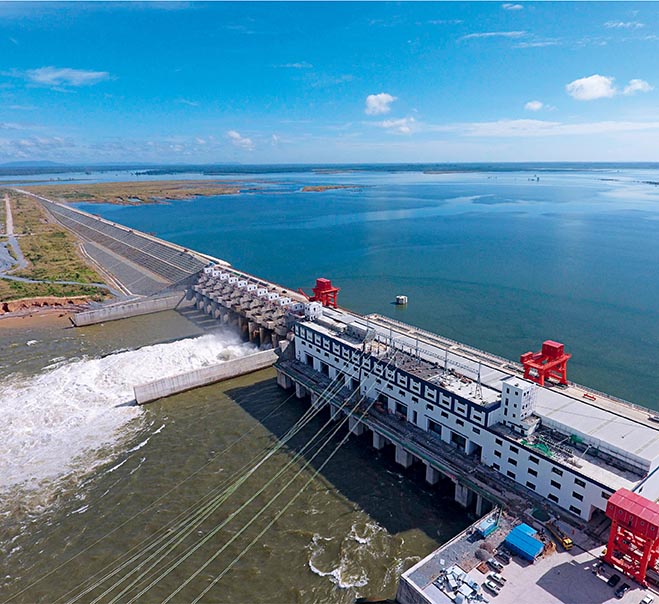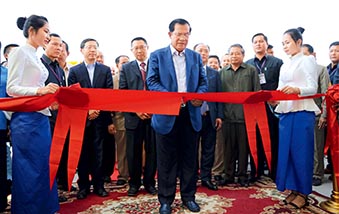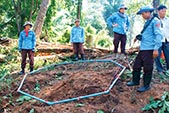The Lower Se San 2 Dam (LSS2), a 6.5-kilometer-long hydroelectric dam on the Se San River in Cambodia’s Stung Treng Province, is the largest hydropower project in the country and the longest dam in Asia, which created a giant 330-square-kilometer reservoir. The unpredictable flow of the Se San River is ideal for the dam to generate electricity and regulate downstream flow. As a key project that integrates China’s Belt and Road Initiative (BRI) with Cambodia’s Rectangular Strategy, the dam is operated by Hydro Power Lower Se San 2 Co. Ltd., a joint venture between the Royal Group of Cambodia and Hydrolancang International Energy, a subsidiary of China Huaneng Group. The project has been providing strong energy support for Cambodia’s economic and social development.
“Completion of the Lower Se San 2 Dam will solve many problems hindering Cambodia’s development,” said Cambodian Prime Minister Hun Sen at the completion ceremony. “Operation of the dam will promote development of Cambodia’s industry, agriculture, manufacturing, tourism and hospitality. It will reduce the cost of electricity, alleviate poverty, and contribute to Cambodia’s energy security.”
Normal Operation amid Coronavirus Outbreak
The sudden outbreak of COVID-19 at the beginning of 2020 tested the management and operation capacity of LSS2. The company has tackled pandemic containment and continued business operation as equally crucial. A solid “firewall” was built for its workforce from both countries, who were stationed at the dam and in other locations in Stung Treng Province. No one involved in the project was ever infected with the virus, and operation of the power plant was never interrupted.
“Because of the pandemic, many of my colleagues who were back in China for the Spring Festival couldn’t come back to work as expected,” recalled Li Mingru, manager of the power plant’s operation and maintenance department. “Many local maintenance workers couldn’t come back to work either. Everyone stuck at their post had to assume a lot more responsibility to overcome the difficulties together.” Facing its greatest test yet, the power plant maintained high-standard operation despite a reduced workforce. In less than two months before the flood season, it overhauled five generating units, installed an overhead double-circuit transmission line, and accomplished 110 other key tasks such as generating unit defect elimination, hidden trouble detection, and technical renovation.
Cambodia has rich water resources, but its development capacity has remained limited. It has wrestled the problem of insufficient power supply by becoming highly dependent on energy imports. LSS2 has a water storage capacity of 2.72 billion cubic meters and an installed capacity of 400,000 kilowatts, accounting for nearly 20 percent of Cambodia’s total installed power capacity. It provides Cambodia nearly 2 billion kilowatt hours of clean energy every year, easing the country’s energy shortage and reducing costs significantly. Today, the annual electricity consumption by Cambodia’s population of 15 million is roughly 12 billion kilowatt hours. The LSS2 can meet the energy needs of more than 2 million Cambodians.
“The LSS2 is a central force of Cambodia’s power supply,” commented Suy Sem, Cambodian Minister of Mines and Energy. He explained that the power plant has promoted construction of energy infrastructure in surrounding areas such as Phnom Penh, Kampong Cham, and Kratie, improving the country’s energy independence and security. He called the project highly significant in terms of accelerating development of hydropower resources in the Mekong River Basin and improving Cambodia’s energy structure.
The power plant has also acted as a sort of “regulator” of Cambodia’s power supply. In February 2020, the LSS2’s electricity output accounted for 57.2 percent of Cambodia’s total output of its kind. On February 25, some Cambodian power plants went offline, exerting a major impact on the safe operation of the local power grid. The LSS2 launched all eight of its units including four spares to ensure a stable power supply for millions until the other plants resumed operation. The project has been providing lasting and reliable power to ensure continued normal operation of Cambodia’s power grid and stabilize economic and social development.
Environmentally-Friendly Project
Before construction began, the site of the dam was covered by untamed forest. Many years of war in the region had left the area littered with landmines and other explosives. To ensure safe construction, mine clearance was carried out ahead of any work. It took the Cambodian Mine Action Center an entire year to complete comprehensive mine clearance in engineering exploration, construction, and reservoir areas. A total of 207 explosives were successfully removed.
In October 2013, the construction project kicked off. In the following five years, construction workers from both countries overcame multiple difficulties such as the unfavorable natural environment, frequent disease outbreaks, shortages of resources, and inconvenience for equipment transportation and traffic. All eight turbine units reached full operation in October 2018, a record pace for construction of a hydroelectric project in Cambodia. The minimum head and unit capacity of the 50,000-kilowatt light bulb tubular turbine units, made in China, lead such components globally.
Since the beginning of the project, the construction teams prioritized environmental protection on equal footing with development. They sought to build an eco-friendly demonstration project to safeguard the Se San River Basin. To minimize the impact of the project on the river’s ecology, meet the passage needs of migratory fish, and maintain fish diversity in the region, the project invested US$1.5 million to construct a bionic fishway to the right of the dam even though it was not required by the BOT agreement or requested by the Cambodian government.
The bionic fishway provides a route for migratory fish to bypass the dam and also serves as a wider ecological corridor. From atop the dam, a rockpool water slide staggered with stone barriers every 5 to 10 meters is clearly visible. Barriers separate the water slide into small pools to reduce the difference in water levels between the upper and lower reaches. Each pool has an opening for the fish to pass through. The fishway stretches about 3,000 meters. A number of “R&R pools,” which are 100 meters long, 50 meters wide and 2.5 meters deep, were built 800 meters apart for migratory fish from the lower reaches to rest before continuing to the upper reaches or vice versa. While providing migratory fish a rest area, the pools also offer tourists a platform to observe behavior of migratory fish, which can help promote public awareness of environmental protection.
A series of protective measures have ensured the LSS2 coordinates development of resources with environmental protection. It is also noteworthy that the power plant is equipped with a complete on-site domestic sewage treatment system to effectively provide recycled wastewater for irrigation of surrounding greenery.
Better Living for Locals
“In the relocation village, we have maintained our traditional way of life involving farming and fishing,” reported Kongka, a villager who moved because of the project. “We now have better transportation, education, sanitation, and much more farmland than before. If we keep working hard, things continue to get better and better!”
Kongka has big future plans. He is now cultivating three hectares of farmland with rice while sitting on another two hectares until he saves enough to plant cashews and mango trees. “We don’t have to worry about selling our products at all, because our village is right next to Highway 78. It’s very easy for merchants to get our products.”
Relocation to make way for Cambodia’s largest hydroelectric project ever was the largest in scale in the history of the region. The project working group took concrete action to help the villagers solve persisting problems such as poverty in the process.
After analyzing the local conditions, the relocation working group found three locations and offered three models for the villagers to choose from, so most would continue to live in concentrated communities to efficiently use farmland and resources. The villagers could also choose to live in either a traditional wooden house or a modern brick house. A school, a hospital, a temple, and a police station were built in Sai Ku, one relocation village, alongside infrastructure such as drainage, water supply, and power lines.
“My family of five used to live in a thatched house,” said Faye Buntan, Sai Ku’s village head. “The leaky roof didn’t keep the rain out very well. The village didn’t have access to electricity or a highway. Those days were very tough.” In 2015, Buntan moved his family into a traditional stilted house built of wood and cement on a 1,000-square-meter plot. Five hectares of farmland were allocated for the family.
“We haven’t been back to the old village since we moved here,” she continued. “Everything is new here: new houses, new roads, new wells, and everything else. The power plant also ensures us a low-cost power supply. Life is much easier now.”
It was gratifying to planners to see relocation villages enhanced their capacity for independent development thanks to the assistance they received. The project provided relocated villagers with grain assistance, as well as farming technology and education, to help them and their offspring to seamlessly adapt to life in the new villages while climbing out of poverty.
Today, the shiny relocation villages gleam with rows of stilted houses with red walls and blue roofs including schools, clinics, and other public facilities. Highway 78 connecting to the outside world winds through the surrounding mountains of northeastern Cambodia. In the evening, the villages continue to bustle with villagers enjoying modern pop culture on TV, especially Chinese series, in the remote corner of the world.
Dreams Coming True
“This job has not only improved my life, but also fulfilled my dream of becoming an electrical engineer,” declared Pan Sophara, a 25-year-old local engineer who adopted the Chinese name Gao Yifan. After four years of on-the-job training, he has become a skilled electrical engineer.
After graduation from Cambodia’s Phnom Penh Institute of Technology, Sophara was hired at LSS2 as a trainee in the operation and maintenance department. He was part of the first group of Cambodian employees to be engaged in production technology.
“At first, I didn’t understand what the curves on the instruments meant, which left me very confused and helpless,” admitted Sophara. To solve this problem, his Chinese supervisor helped him patiently.
In January 2020, LSS2 organized a trip to China for its Cambodian employees to visit Huaneng Group’s new energy projects including photovoltaic power plants and wind farms.
“We were very fortunate to see first-hand what we only read about in school textbooks,” said Sophara after the visit. “I hope that help from Huaneng and other companies will enable us to build similar large scale green energy projects in Cambodia.” He shared his findings from the trip with his local colleagues at LSS2, including Chinese experience on new energy and environmental protection.
At LSS2, more than a fifth of the employees working in production technology are local. The proportion of local employees in other jobs is even higher. Experience with Huaneng Group teaches them about both China’s advanced power technology and its experience in production management. Since the beginning of the project, a total of 220 Cambodian citizens have been employed in operation and maintenance, comprehensive management, logistics, and other sectors. At the peak of construction, the project was employing more than 2,000 locals.
During a visit to the dam, Mom Saroeun, Governor of Stung Treng Province, declared that LSS2 had not only greatly improved the power supply for local factories and residents, but also created many jobs for local people and nurtured a capable group of local engineering and hydropower technology professionals.
“The BRI brought us development opportunities,” he said. “I believe more and more foreign investors will start looking at this province.”

An aerial view of the Lower Se San 2 Dam.

Cambodian Prime Minister Hun Sen cuts the ribbon at the completion ceremony of the Lower Se San 2 Dam. (HUANG YAOHUI)

Experienced deminers remove landmines and other explosives from a construction site.

Local engineer Pan Sophara (right) performs preventative electrical testing.
L0057.T001.JPG
The Lower Se San 2 Dam (LSS2), a 6.5-kilometer-long hydroelectric dam on the Se San River in Cambodia’s Stung Treng Province, is the largest hydropower project in the country and the longest dam in Asia, which created a giant 330-square-kilometer reservoir.
LSS2 has a water storage capacity of 2.72 billion cubic meters and an installed capacity of 400,000 kilowatts, accounting for nearly 20 percent of Cambodia’s total installed power capacity.
L0057.T002.JPG
It provides Cambodia nearly 2 billion kilowatt hours of clean energy every year, easing the country’s energy shortage and reducing costs significantly.
L0057.T003.JPG
In February 2020, the LSS2’s electricity output accounted for 57.2 percent of Cambodia’s total output of its kind.


 Copy Reference
Copy Reference